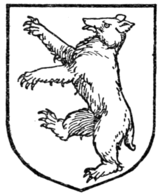or crests, for example, of Fox, Colfox, and Ashworth. Probably the most curious example of the heraldic fox will be found in the arms of Sir Watkin Williams Wynn, who for the arms of Williams quarters: "Argent, two foxes counter-salient gules, the dexter surmounted of the sinister." The face of a fox is termed its mask (Fig. 345).
The Bear (Figs. 346-349) is frequently found figuring largely in coats of arms for the names of Barnard, Baring, Barnes, and Bearsley, and for other names which can be considered to bear canting relation to the charge. In fact the arms, crest, and motto of Barnard together form such an excellent example of the little jokes which characterise heraldry that I quote the blazon in full. The coat is "argent, a bear rampant sable," the crest is "a demi-bear sable," and the motto "Bear and forbear."
 Fig. 346.—Bear rampant. |
 Fig. 347.—Bear passant. |
 Fig. 348.—Bear statant. |
The bear is generally muzzled, but this must not be presumed unless mentioned in the blazon. Bears' paws are often found both in crests and as charges upon shields, but as they differ little if anything in appearance from the lion's gamb, they need not be further particularised. To the bear's head, however, considerable attention should be paid, inasmuch as the manner of depicting it in England and Scotland differs. The bear's head, according to English ideas of heraldry, would be depicted down to the shoulders, and would show the neck couped or erased (Fig. 350). In Scottish heraldry, bears' heads are almost invariably found couped or erased close behind the ears without any of the neck being visible (Figs. 351 and 352); they are not, however, represented as caboshed or affronté.
The Boar is an animal which, with its parts, will constantly be met with in British armory (Figs. 353-355). Theoretically there is a difference between the boar, which is the male of the domestic animal, and the wild boar, which is the untamed creature of the woods. Whilst the latter is usually blazoned as a wild boar or sanglier, the latter is just a boar; but for all practical purposes no difference what-
